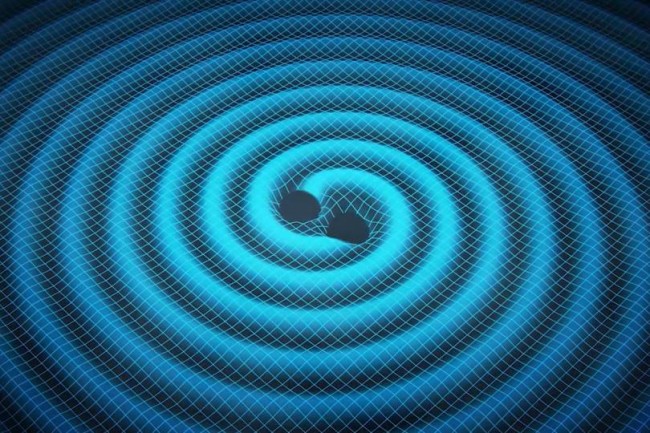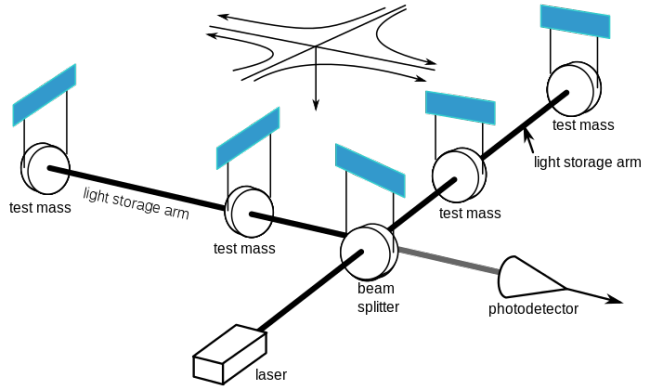
PHOTO: SWINBURNE ASTRONOMY PRODUCTIONS
There is a lot of back chatter, excitement and tweets flowing about the probable discovery of Gravitational Waves.
“Hey wait a second, that was announced already“, you might say. True indeed, there was an announcement made on 17 March 2014, but that was withdrawn on 30 January 2015 because further analysis concluded that “the signal can be entirely attributed to dust in the Milky Way”.
This is something quite different, LIGO (The Laser Interferometer Gravitational-Wave Observatory) began making observations last september and it looks like they have got the goods … probably.
My earlier rumor about LIGO has been confirmed by independent sources. Stay tuned! Gravitational waves may have been discovered!! Exciting.
— Lawrence M. Krauss (@LKrauss1) January 11, 2016
Don’t hold your breath waiting, it will take a bit of time yet before this all becomes official …
The official word from the LIGO team is that they are still analysing the data from the first run, which should finish on 12 January. “It takes time to analyse, interpret and review results,” says spokesperson Gabriela González at Louisiana State University. “We expect to have news on the run results in the next few months.”
It is apparently now news
The Guardian has the story, but they do correctly identify it as a 60% probability right now …
According to the rumours, scientists on the team are in the process of writing up a paper that describes a gravitational wave signal. If such a signal exists and is verified, it would confirm one of the most dramatic predictions of Albert Einstein’s century-old theory of general relativity.
Krauss said he was 60% confident that the rumour was true, but said he would have to see the scientists’ data before drawing any conclusions about whether the signal was genuine or not.
In fact many media outlets are now reporting it …
- New Scientist – New rumours that gravitational waves have finally been detected
- International Business Times – Gravitational Waves Discovered? A Physics Rumor Sends Shockwaves Across Twitter
OK, so what exactly is LIGO and what have they detected?
You can read about Gravitational Waves here, but basically …
As objects with mass move around in spacetime, the curvature changes to reflect the changed locations of those objects. In certain circumstances, accelerating objects generate changes in this curvature, which propagate outwards at the speed of light in a wave-like manner. These propagating phenomena are known as gravitational waves.
… and so LIGO is a setup designed to detect this. In fact it is not one detector, but 3, all located at different places, and so that will give them some good results if they all report the same at the same time. The idea of the detector is to have a light source running two beams, each about 4 Km long and at right angles … like this …
… and what then happens is that as a gravitational wave passes and distorts spacetime, it will ever so slightly shorten one and lengthen the other and that can then be measured and detected.
Once you get the basics right, then you have potentially opened a new window on the universe and so we would be able to start looking beyond the limits imposed currently by the electromagnetic spectrum – and that makes all this very exciting. That would of course require far better detectors and already in anticipation of that there are plans to go space based and occupy a solar orbit trailing the Earth, with each arm of a laser triangle being five million kilometres long.
Something truly new
Apart for the actual discovery itself, which is of course exciting, we now also have something else that is perhaps quite new. The excitement within the scientific community is bubbling away and out in the open because some folks who live and breath life at the cutting edge of science will quite naturally tweet about things like this, and so we all now get to see that happen, and get the hear about it long before the far more formal announcements.

https://ligoskeptic.wordpress.com/2016/02/17/lol-ligo-fake-bicep2ligo-cargo-cult-science-experiments-and-injected-signals-being-used-to-provethe-fake-science-of-strings-m-theory-cosmic-strings-inflation-and-multiverse-mania/
Feynman reminds us of Science’s Exalted Soul in his speech Cargo Cult Science:
The first principle is that you must not fool yourself (The first principle of the failed multiverse maniac is that YOU MUST FOOL YOURSELF!)—and you are the easiest person to fool (Which is good for the multiverse maniac!). So you have to be very careful about that. After you’ve not fooled yourself, it’s easy not to fool other scientists (the multimillioniare multiverse maniac gets rid of all scientists he cannot fool. Hence Guth tenured Tegmark). You just have to be honest in a conventional way after that.
I would like to add something that’s not essential to the science, but something I kind of believe, which is that you should not fool the layman (NSF pours billions of dollars into creating BICEP2/LIGO videos to fool the layman!) when you’re talking as a scientist. I’m not trying to tell you what to do about cheating on your wife, or fooling your girlfriend, or something like that, when you’re not trying to be a scientist, but just trying to be an ordinary human being. We’ll leave those problems up to you and your rabbi. I’m talking about a specific, extra type of integrity that is not lying, but bending over backwards to show how you’re maybe wrong, that you ought to do when acting as a scientist (TODAY’S MULTIMILLIONAIRE MULTIVERSE MANIACS BEND OVER BACKWARDS TO BROWN-NOSE THE SENIOR FAILED SCIENTISTS AND MISLEAD THE PUBLIC). And this is our responsibility as scientists, certainly to other scientists, and I think to laymen.
For example, I was a little surprised when I was talking to a friend who was going to go on the radio. He does work on cosmology and astronomy, and he wondered how he would explain what the applications of this work were. “Well,” I said, “there aren’t any.” He said, “Yes, but then we won’t get support for more research of this kind.” I think that’s kind of dishonest. If you’re representing yourself as a scientist, then you should explain to the layman what you’re doing (OBSERVING COSMIC DUST IN BICEP2)—and if they don’t want to support you under those circumstances, then that’s their decision.
One example of the principle is this: If you’ve made up your mind to test a theory, or you want to explain some idea, you should always decide to publish it whichever way it comes out (WHY NOT SHARE ALL THE NON-LIGO SIGNALS AND THE REASONS WHY ONLY ONE “SIGNAL” WAS EVER SEEN??!!!). If we only publish results of a certain kind (IF YOU ONLY PUBLISH ONE LIGO RESULT!!!), we can make the argument look good. We must publish both kinds of result. For example—let’s take advertising again—suppose some particular cigarette has some particular property, like low nicotine. It’s published widely by the company that this means it is good for you—they don’t say, for instance, that the tars are a different proportion, or that something else is the matter with the cigarette. In other words, publication probability depends upon the answer. That should not be done.